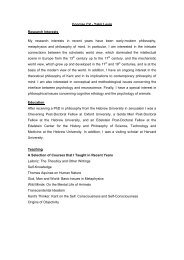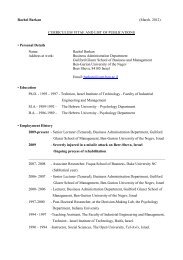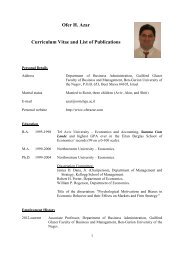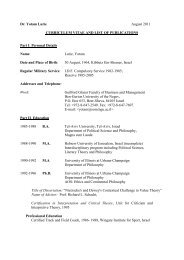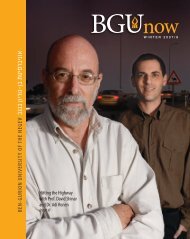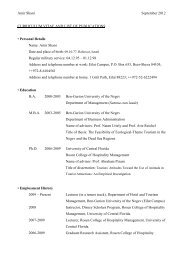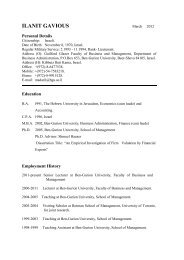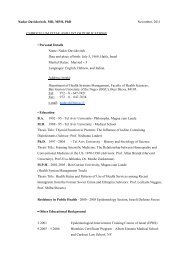cover 2006
cover 2006
cover 2006
You also want an ePaper? Increase the reach of your titles
YUMPU automatically turns print PDFs into web optimized ePapers that Google loves.
the puppet and then a second<br />
puppet is shown going behind the<br />
screen. When the screen is removed,<br />
either one or two puppets are<br />
revealed. One would expect to see<br />
two puppets: 1 + 1 = 2. But if there’s<br />
only one puppet, i.e., the incorrect<br />
result, how does the infant respond?<br />
“We tried to check how much a<br />
baby understands and if it is able to<br />
make some basic mathematical<br />
calculations, and how to distinguish<br />
whether they are correct or<br />
incorrect,” explains Berger. The<br />
researchers are also filming the<br />
baby’s face so they can analyze eye<br />
movements.<br />
“Babies look longer at the<br />
incorrect answer because they<br />
perceive the error. That means the<br />
baby can differentiate when<br />
something conflicts with what it has<br />
perceived. Its brain reacts in a<br />
different way when it recognizes<br />
that there is something wrong. Our<br />
initial results show that an infant’s<br />
brain works very much like that of<br />
an adult,” she concludes. Using the<br />
ERP technique, Berger’s researchers<br />
are able to identify the exact<br />
millisecond when the baby is<br />
presented with an impossible event<br />
and can examine the brainwaves<br />
and pattern of activity. There has<br />
long been an assumption that<br />
human beings have an innate mental<br />
ability to process quantities in the<br />
environment. Berger believes this<br />
research proves that theory. Her<br />
research also shows that the basic<br />
brain circuitry involved in the<br />
detection of errors is already<br />
functional before the end of the first<br />
year of life. This data is being<br />
published in the prestigious<br />
Proceedings of the National Academy<br />
of Sciences of the United States of<br />
America (PNAS).<br />
Berger studied for her B.A., M.A.<br />
and Ph.D. degrees at Bar Ilan<br />
University and is conducting her<br />
study jointly with Prof. Michael<br />
Posner at the University of Oregon,<br />
an institution at the leading edge of<br />
ERP research and the place where<br />
she did her post-doctoral work. Their<br />
research is being supported by the<br />
US-Israel Binational Science<br />
Foundation.<br />
Berger, who joined the BGU<br />
faculty in 2000, was the first to bring<br />
the geodesic-net ERP tool to Israel<br />
and apply it to research on infants.<br />
There is some evidence that babies at a very<br />
young age have some understanding of<br />
quantities, even addition and subtraction<br />
“The overall direction of our work<br />
is to look for the development of<br />
executive attention and cognitive<br />
functions in babies. The way I<br />
decided to do it was to connect it to<br />
the babies’ perception of quantities.”<br />
She believes that some day the<br />
tools used in this research could be<br />
applied to detecting learning<br />
disabilities or developmental<br />
problems at a much earlier age. The<br />
findings might one day even help<br />
in devising ways to teach children<br />
mathematics more effectively.<br />
In Memoriam<br />
Shraga Segal<br />
The University community<br />
mourned the sudden death of<br />
Deputy-Rector Prof. Shraga Segal.<br />
A faculty member for more than 30<br />
years, Segal helped to establish the<br />
Faculty of Health Sciences.<br />
Incumbent of the Joseph H. Krupp<br />
Chair in Cancer Immunobiology,<br />
he was one of the leaders of<br />
immunological research in Israel<br />
and shaped the University’s<br />
curriculum on molecular biology,<br />
general and clinical microbiology<br />
and immunology.<br />
Segal held a number of senior<br />
administrative positions including<br />
Dean of the Faculty of Health<br />
Sciences, Head of the University’s<br />
Center for Cancer Research, Acting<br />
Director of the Institute for Applied<br />
Biosciences in its transitionary<br />
period as it became the nucleus of<br />
the National Institute of<br />
Biotechnology in the Negev, and<br />
served two tenures as Chairman of<br />
the Department of Microbiology<br />
and Immunology.<br />
May his memory be blessed.<br />
BGU NOW 23



